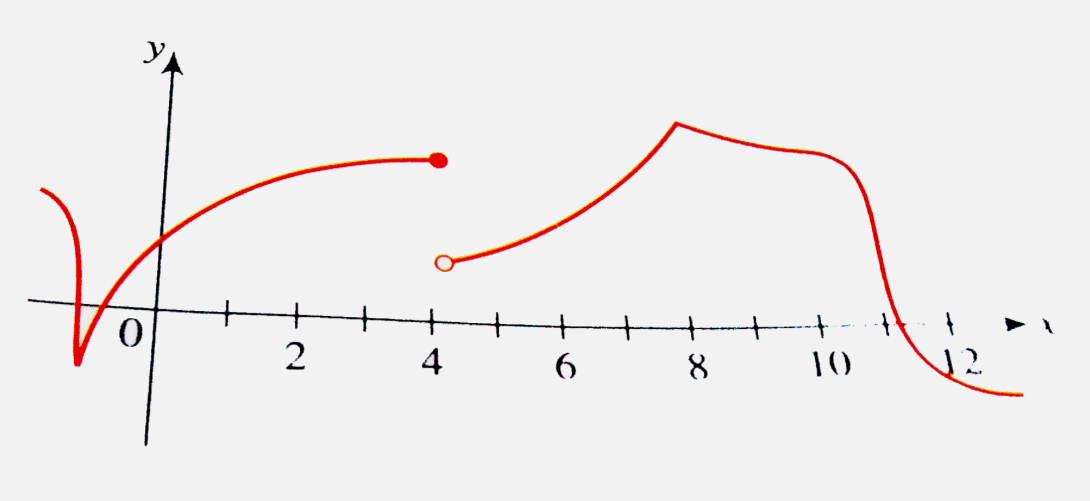Which of the following function is non- differentiable ?
f(x)=(ex−1)∣∣e2x−1∣∣inR
f(x)=x−1x2+1inR
f(x)={||x−3|−1|x<3x3[x]−2x≥3
where [.] represents the greatest integer function
f(x)=3(x−2)34+3inR
The correct Answer is:D
To determine which of the given functions is non-differentiable, we will analyze each option step by step.
Step 1: Analyze the first function
The first function is given as:
f(x)=ex−1+|e2x−1|
1. Break down the absolute value:
|e2x−1|={e2x−1if e2x≥1−(e2x−1)if e2x<1
Since e2x is always positive, it will never be less than 1 for any real x. Thus, we can simplify:
|e2x−1|=e2x−1
2. Combine the terms:
f(x)=ex−1+(e2x−1)=ex+e2x−2
3. Check differentiability:
The function ex and e2x are both differentiable everywhere. Therefore, f(x) is differentiable.
Step 2: Analyze the second function
The second function is:
f(x)=1x−1
1. Check for points of non-differentiability:
The function is a rational function and is differentiable everywhere except where the denominator is zero. The denominator x−1=0 at x=1.
2. Conclusion:
The function is non-differentiable at x=1.
Step 3: Analyze the third function
The third function is:
f(x)=|x−3|−|x−3|−1 for x<3
f(x)=x3 for x≥3
1. Break down the absolute values:
For x<3:
f(x)=3−x−1=2−x
For x≥3:
f(x)=x3
2. Check differentiability at x=3:
- Left-hand derivative at x=3:
f′(x)=−1
- Right-hand derivative at x=3:
f′(x)=13
Since the left-hand and right-hand derivatives at x=3 are not equal, the function is non-differentiable at x=3.
Step 4: Analyze the fourth function
The fourth function is:
f(x)=⌊x⌋−2 for x<2
f(x)=34x for x≥2
1. Check for points of non-differentiability:
The floor function ⌊x⌋ is not differentiable at integer points. At x=2, the function changes from a step function to a linear function.
2. Conclusion:
The function is non-differentiable at x=2.
Final Conclusion
After analyzing all the functions, we find that:
- The first function is differentiable.
- The second function is non-differentiable at x=1.
- The third function is non-differentiable at x=3.
- The fourth function is non-differentiable at x=2.
Thus, the functions that are non-differentiable are the second, third, and fourth functions.
The first function is given as:
f(x)=ex−1+|e2x−1|
|e2x−1|={e2x−1if e2x≥1−(e2x−1)if e2x<1
Since e2x is always positive, it will never be less than 1 for any real x. Thus, we can simplify:
|e2x−1|=e2x−1
f(x)=ex−1+(e2x−1)=ex+e2x−2
The function ex and e2x are both differentiable everywhere. Therefore, f(x) is differentiable.
The second function is:
f(x)=1x−1
The function is a rational function and is differentiable everywhere except where the denominator is zero. The denominator x−1=0 at x=1.
The function is non-differentiable at x=1.
The third function is:
f(x)=|x−3|−|x−3|−1 for x<3
f(x)=x3 for x≥3
For x<3:
f(x)=3−x−1=2−x
For x≥3:
f(x)=x3
- Left-hand derivative at x=3:
f′(x)=−1
- Right-hand derivative at x=3:
f′(x)=13
The fourth function is:
f(x)=⌊x⌋−2 for x<2
f(x)=34x for x≥2
The floor function ⌊x⌋ is not differentiable at integer points. At x=2, the function changes from a step function to a linear function.
The function is non-differentiable at x=2.
After analyzing all the functions, we find that:
- The first function is differentiable.
- The second function is non-differentiable at x=1.
- The third function is non-differentiable at x=3.
- The fourth function is non-differentiable at x=2.
Similar Questions
Which of the following function is thrice differentiable at x=0?
View SolutionWhich of the following functions is differentiable at x=0?
View SolutionWhich of the following functions is non-periodic?
View SolutionThe following functions are differentiable on (-1,2)
View SolutionWhich of the following functional group is non chain terminating functional group
View SolutionWhich of the function is non-differential at x=0? f(x)=∣∣x3∣∣
View SolutionWhich of the function is non-differential at x=0? f(x)=cos|x|
View SolutionWhich of the function is non-differential at x=0? f(x)=x|x|
View SolutionIf f(x) and g(x) are differentiable and increasing functions then which of the following functions alwasys increases?
View SolutionThe graph of f(x) is given. State with reasons the number at which the function is non-differentiable.

View Solution
